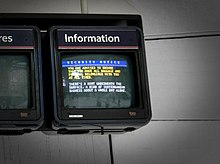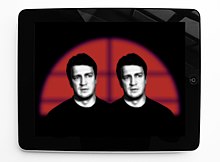Martin Firrell
[2] Firrell uses language to engage directly with the public, provoking dialogue, usually about aspects of marginalisation, equality and equitable social organisation.
He read early 20th-century literature extensively, citing the works of Virginia Woolf, Gertrude Stein, and the French writer Marguerite Duras (with whom he shares his birthday and a high degree of political sympathy) as key influences on his later development.
"[6] Firrell sets out to remedy Nin's "worthlessness" of words by using language to raise provocative questions about society, relevant to the vast majority of people and freely available in public.
[1] British social historian Joe Moran suggests Firrell is consequently well equipped to hijack public space with stealthily subversive declarations like 'Protest is liberty's ally'.
[8] In most of Firrell's works it becomes apparent that uppermost is the belief in the redemptive power of ideas, directed at extending or protecting the right of the individual to create his or her own unique way of life and to live it accordingly without interference.
Complete Hero, created whilst the artist was in residence with the British Army, invited the contribution of ideas, experiences and opinions, which formed the greater proportion of the project as it evolved on the internet.
[10] Firrell has held that the purpose of existence is to develop the richness and meaning of lived experience, that art and culture in general should be key contributors to this central project and that their success or otherwise can be measured against this criterion.
"[11] As Royal Opera House Creative Director Deborah Bull said of Firrell: "Yes he's a provocateur if you like, but the underlying message is very rarely 'life's rubbish and you're all a bunch of sharks'....
Firrell has used digital billboards, cinema screens, newsprint, the internet, portraiture and video interviews of culturally significant figures like Howard Jacobson, April Ashley, Johnson Beharry VC, and A C Grayling, and large-scale digital projection onto the Guards Chapel, spiritual home of the Household Division of the British Army,[10] the National Gallery in London,[13] the Houses of Parliament, the Royal Opera House, Covent Garden,[14] Tate Britain,[15] and St Paul's Cathedral.
These organisations have engaged with audacious, self-questioning project content, including "I don't think this is what God intended" (West Front, St Paul's Cathedral, 2008) and "War is always a failure" (North elevation, Guards Chapel, 2009).
The Question Mark Inside,[11] a television documentary produced by Simon Channing Williams and Colin Burrows was first broadcast by Sky Arts 1 on 29 October 2009, and provided new insights into Firrell's opinions, aims, daily life and practice.
Ten years later, Firrell was the subject of a second documentary Overthrow the Social Order, directed by Oliver Guy-Watkins first broadcast by Sky Arts in New Zealand on 21 May 2018.
[17] Firrell's body of work includes investigations into portraiture (Text Portrait of Howard Jacobson, Booker Prize winner, 2010) and explorations of the power of mass popular culture to propagate socially useful ideas, in particular, the science fiction genre.
[25] Metascifi (iOS app published 4 April 2015, now retired)[26] mined popular American television science fiction for philosophical ideas with direct bearing on the project of enriching lived experience.
Video portraiture draws out life lessons from Fielding's roles as the vampiric Valeria Watt in Carry On Screaming, as Herself and Lady Hamilton in The Morecambe & Wise Show, and as The Voice in the cult TV series The Prisoner.
The project consists of 13 texts presented where postcards customarily display a picture, and a 14th card showing a photographic portrait of the artist (taken by Russian Concert Pianist, Yekaterina Lebedeva, using a disposable camera) on the Pont des Arts in Paris, mid cartwheel.
Firrell was Public Artist in Residence with the Household Division of the British Army in 2009, developing Complete Hero for projection onto the Guards Chapel in November 2009.
"[37] A stream of possible answers, from the domestic to the sublime, appeared as text projections onto the south elevation of the cathedral dome, the West Front at Ludgate Hill and inside onto the Whispering Gallery.
[39] In a 2014 interview for the bureau of sensory intelligence, Firrell responded to the question: "What qualities do you most admire in an object" with the statement, "Its power to provoke; economy of means; symmetry; the colour blue; text; an insistence (implied or inferred) on justice."
















